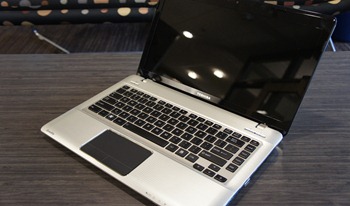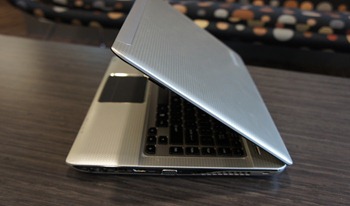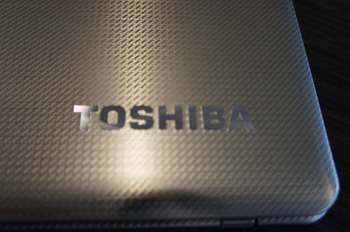About a year ago I reviewed the Toshiba Satellite E205, one of Best Buy’s second generation “Blue Label” PCs.” It was a really good computer for the time and sported never-before-seen technology like Intel Wireless Display (aka “WiDi), and you could get it for about $1,000. Flash forward to today, and you’ve got the brand new Toshiba Satellite E305, the follow up to last year’s Satellite E205. Like its predecessor it’s reasonably priced ($899), loaded with top-end specs (14” HD display, second generation Core i5 processor, 4GB RAM, 7200 RPM 500GB hard drive, USB 3.0, LED backlit keyboard, built in 4G WiMAX and Blu-Ray), and looks great.
Look and Feel
The Satellite E305 has a newly redesigned chassis that’s made from a textured aluminum. This not only looks great but it’s highly functional too – the aluminum makes the PC very rigid and durable and the texturing goes a long way towards resisting fingerprints. The PC is also very well balanced which allows for easy one-handed opening. Those of you who read my reviews know that this is a big deal for me – I hate it when opening a PC requires two hands!
Rather than using a trackpad/button combo, Toshiba uses a clickpad on the Satellite E305 that’s finished with the same texture of the case. It’s a nice touch that makes the trackpad feel like an integrated part of the chassis design, rather than something that was just plopped down in the middle for functionality’s sake. I’m not a huge fan of clickpads (I prefer the ergonomics of real buttons), but Toshiba’s implementation is good. It’s smooth and responsive, while Synaptics’ new driver allows for full multi-touch gesture support and new functions like a two-finger right click that feel natural and are easy to pick up. To complement the new clickpad Toshiba included a backlit keyboard, which is very useful for typing in low-light conditions like an airplane or a dark lecture hall.
Under the front bezel are stereo speakers that deliver excellent sound quality, especially thanks to the built-in Dolby Advanced Audio suite. I easily filled the room with music from my ZunePass. Music sounded surprisingly rich for such a small set of speakers with clear highs and deep lows.
Performance
The Satellite E305 is a performance monster! The second-generation Core i5 processor was very responsive when I was plowing through my normal battery of productivity tests using Office 2010 and IE9, and that, coupled with second-generation Intel HD graphics made playing HD videos (both online and through Zune) a breeze. I was really impressed by the video playback – the clarity and color depth of the 14” display is better than a lot of notebooks in this class. I didn’t game on the Satellite E305 but judging from the specs and my experience with video, it should be able to handle even intensive games well.
Battery life was outstanding and I got nearly 8 full hours of consistent on-line work time out of the PC off of a full charge. That length is largely due to the energy saving properties of Intel’s new Core processors and integrated graphics, and it’s great to see “Sandy Bridge” delivering in the real world. Even for a road warrior like me 8 hours of battery life is plenty. I’m rarely away from an outlet for that long when I’m travelling around campus, and that length is sufficient to get me from Seattle to New York, and almost from Seattle to London, on a single charge.
Two technologies built into the Satellite E305 that I didn’t get a chance to test are the integrated WiMAX 4G wireless and Intel WiDi 2.0. The latter is really cool stuff – it allows you to stream your display in real-time to any TV using the included NETGEAR Push2TV HDTV adapter. Just connect the adapter to your TV, hit the WiDi button, and you’re good to go. Last year I shot a video on WiDi 1.0 using the Toshiba Satellite E205, so I highly recommend watching that to see how WiDi works. Notable changes in WiDi 2.0 are the ability to push full 1080p content and a reduction in PC-to-TV lag.
In my fundamentals testing the Satellite E305 performed really well. Like all Toshibas, it woke up almost instantly. I don’t know what those guys do to the drivers to get their PCs to come out of sleep so fast, but I like it!
- Startup (cold boot to desktop): 34 seconds
- Shut down (No apps open, button press to power off): 16 seconds
- Sleep (lid close to power off): 6 seconds
- Wake (lid open to desktop): 1 second
Final Thoughts
Best Buy and Toshiba deserve hearty congratulations for building a PC like the Satellite E305. At $899, it’s a tough laptop to beat in terms of specs and performance, and it looks pretty good, too. All in all, it’s a very good choice as a home laptop, a do-everything PC for school, or a take-it-everywhere SMB computer.
Have a question about this or any other PCs? Post a comment, hit me on Twitter, or Ask Ben Anything via email!






